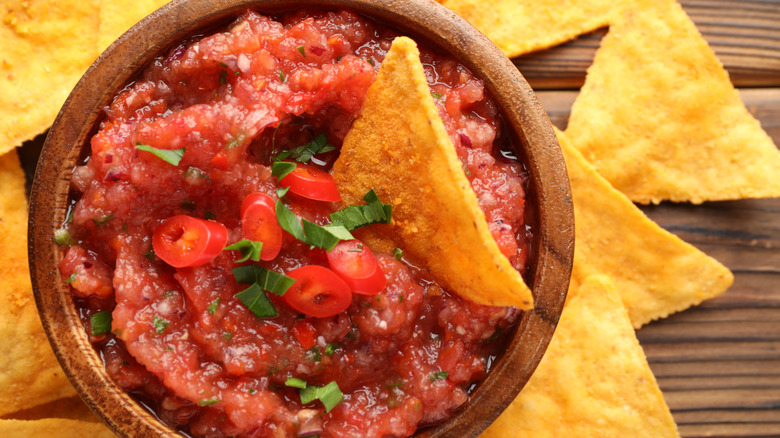Why This Mexican Restaurant Freebie Might Have You Walking Out The Door
When stepping out to enjoy dinner on the town, you expect certain things when the restaurant is a Mexican spot. A complimentary serving of chips and salsa is one of them. Typically, Mexican restaurants don't charge for chips and salsa, leaving patrons free to munch and enjoy as they scan the menu and wait for their entrees. But did you know this gratis goodie can also tell you a lot about the quality of the restaurant you're dining at?
For some insight on this, Food Republic reached out to Scott Groth, chef at I'd Rather Be A Chef. Groth shared some things to watch for when your waiter or waitress deposits that free salsa on your table. "Cold, watery salsa can be a red flag," the chef warned. "Salsa is traditionally served at room temperature, allowing the vibrant flavors to shine."
Whether you're being served salsa or pico de gallo (there's a difference), a quality product is the mark of a good restaurant. In a lower-caliber dining spot, you may actually be consuming a prepackaged condiment or one prepared by a mediocre chef. "[Cold] and water is typically a red flag that indicates either the restaurant hasn't taken the time to drain the tomatoes or is using a pre-made mix from a container," Groth detailed. "Often, with a pre-made mix, they taste better cold because the flavors are out of balance." When chilly and soupy are the leading characteristics, you can expect the rest of your food to be subpar, as well — indicating you might want to dine elsewhere next time. (If you're truly concerned about food quality, walking out of the restaurant at this point isn't necessarily poor dining etiquette.)
The right kind of salsa
On the other side of the culinary spectrum, some salsa green lights can indicate that a Mexican restaurant is likely a good place to eat. "Ideally, a good restaurant is going to be making the salsa on a daily basis, using fresh ingredients," Scott Groth explained. "A good salsa is a balance of flavors: acidity from the tomatoes, heat from the chilis, a burst of freshness from the cilantro, and a squeeze of goodness from the limes. It's all brought together with some salt into a melange of flavor."
When the chips and salsa brought to your table are tasty and fresh, that bodes well for the additional food to come. It's also indicative that the chef or chefs behind the scenes know what they're doing when it comes to preparing Mexican cuisine.
Receiving the condiment at room temperature is also a good indicator — though Groth acknowledged that cold salsa isn't a complete dealbreaker. "The reason I am not committing to it being an absolute red flag is that the salsa may have been made earlier in the day on the prep shift and refrigerated," he explained. "If a customer is there right at the opening of the restaurant, the salsa [may be] cold."


